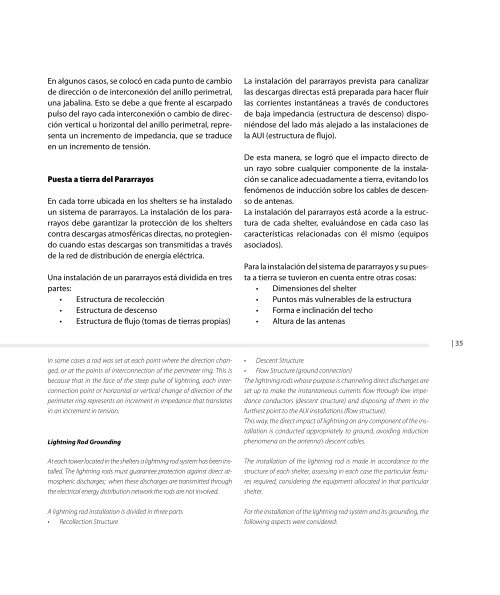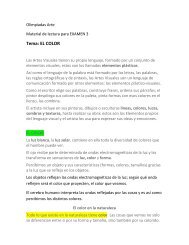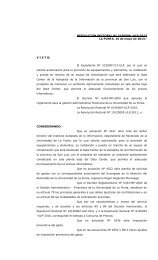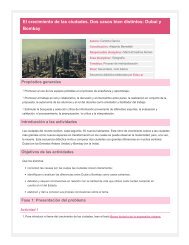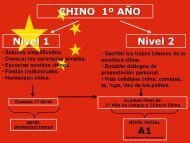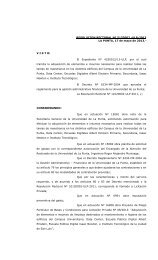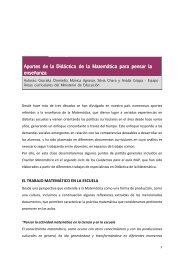e-Book PDF - Universidad de La Punta (ULP)
e-Book PDF - Universidad de La Punta (ULP)
e-Book PDF - Universidad de La Punta (ULP)
Create successful ePaper yourself
Turn your PDF publications into a flip-book with our unique Google optimized e-Paper software.
En algunos casos, se colocó en cada punto <strong>de</strong> cambio<br />
<strong>de</strong> dirección o <strong>de</strong> interconexión <strong>de</strong>l anillo perimetral,<br />
una jabalina. Esto se <strong>de</strong>be a que frente al escarpado<br />
pulso <strong>de</strong>l rayo cada interconexión o cambio <strong>de</strong> dirección<br />
vertical u horizontal <strong>de</strong>l anillo perimetral, representa<br />
un incremento <strong>de</strong> impedancia, que se traduce<br />
en un incremento <strong>de</strong> tensión.<br />
Puesta a tierra <strong>de</strong>l Pararrayos<br />
En cada torre ubicada en los shelters se ha instalado<br />
un sistema <strong>de</strong> pararrayos. <strong>La</strong> instalación <strong>de</strong> los pararrayos<br />
<strong>de</strong>be garantizar la protección <strong>de</strong> los shelters<br />
contra <strong>de</strong>scargas atmosféricas directas, no protegiendo<br />
cuando estas <strong>de</strong>scargas son transmitidas a través<br />
<strong>de</strong> la red <strong>de</strong> distribución <strong>de</strong> energía eléctrica.<br />
Una instalación <strong>de</strong> un pararrayos está dividida en tres<br />
partes:<br />
• Estructura <strong>de</strong> recolección<br />
• Estructura <strong>de</strong> <strong>de</strong>scenso<br />
• Estructura <strong>de</strong> flujo (tomas <strong>de</strong> tierras propias)<br />
<strong>La</strong> instalación <strong>de</strong>l pararrayos prevista para canalizar<br />
las <strong>de</strong>scargas directas está preparada para hacer fluir<br />
las corrientes instantáneas a través <strong>de</strong> conductores<br />
<strong>de</strong> baja impedancia (estructura <strong>de</strong> <strong>de</strong>scenso) disponiéndose<br />
<strong>de</strong>l lado más alejado a las instalaciones <strong>de</strong><br />
la AUI (estructura <strong>de</strong> flujo).<br />
De esta manera, se logró que el impacto directo <strong>de</strong><br />
un rayo sobre cualquier componente <strong>de</strong> la instalación<br />
se canalice a<strong>de</strong>cuadamente a tierra, evitando los<br />
fenómenos <strong>de</strong> inducción sobre los cables <strong>de</strong> <strong>de</strong>scenso<br />
<strong>de</strong> antenas.<br />
<strong>La</strong> instalación <strong>de</strong>l pararrayos está acor<strong>de</strong> a la estructura<br />
<strong>de</strong> cada shelter, evaluándose en cada caso las<br />
características relacionadas con él mismo (equipos<br />
asociados).<br />
Para la instalación <strong>de</strong>l sistema <strong>de</strong> pararrayos y su puesta<br />
a tierra se tuvieron en cuenta entre otras cosas:<br />
• Dimensiones <strong>de</strong>l shelter<br />
• Puntos más vulnerables <strong>de</strong> la estructura<br />
• Forma e inclinación <strong>de</strong>l techo<br />
• Altura <strong>de</strong> las antenas<br />
| 35<br />
In some cases a rod was set at each point where the direction changed,<br />
or at the points of interconnection of the perimeter ring. This is<br />
because that in the face of the steep pulse of lightning, each interconnection<br />
point or horizontal or vertical change of direction of the<br />
perimeter ring represents an increment in impedance that translates<br />
in an increment in tension.<br />
Lightning Rod Grounding<br />
At each tower located in the shelters a lightning rod system has been installed.<br />
The lightning rods must guarantee protection against direct atmospheric<br />
discharges; when these discharges are transmitted through<br />
the electrical energy distribution network the rods are not involved.<br />
A lightning rod installation is divi<strong>de</strong>d in three parts<br />
• Recollection Structure<br />
• Descent Structure<br />
• Flow Structure (ground connection)<br />
The lightning rods whose purpose is channeling direct discharges are<br />
set up to make the instantaneous currents flow through low impedance<br />
conductors (<strong>de</strong>scent structure) and disposing of them in the<br />
furthest point to the AUI installations (flow structure).<br />
This way, the direct impact of lightning on any component of the installation<br />
is conducted appropriately to ground, avoiding induction<br />
phenomena on the antenna’s <strong>de</strong>scent cables.<br />
The installation of the lightning rod is ma<strong>de</strong> in accordance to the<br />
structure of each shelter, assessing in each case the particular features<br />
required, consi<strong>de</strong>ring the equipment allocated in that particular<br />
shelter.<br />
For the installation of the lightning rod system and its grounding, the<br />
following aspects were consi<strong>de</strong>red:


